 W
WAcontia nitidula, the Brixton beauty, is a moth of the family Noctuidae. The species was first described by Johan Christian Fabricius in 1787. It is found in South Africa, Europe, China, Japan and throughout India and Sri Lanka. It has also been recorded from Great Britain, but this record is doubtful.
 W
WAmphipyra perflua is a moth in the family Noctuidae. It is found from Northern Europe, through Siberia as far east as Korea.
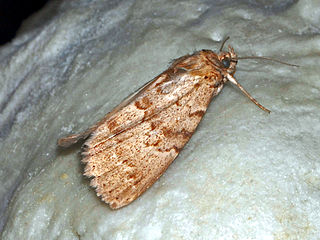 W
WApopestes spectrum is a species of moth in the family Erebidae first described by Eugenius Johann Christoph Esper in 1787.
 W
WArchips betulana is a moth of the family Tortricidae. It is found from Fennoscandia south to Italy, Austria and Slovakia and from the Netherlands and Belgium east to southern Russia and the eastern part of the Palearctic realm.
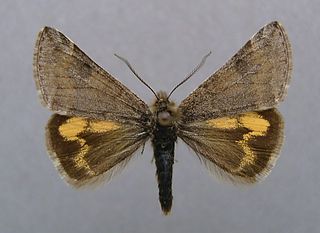 W
WBoudinotiana puella, the pale orange underwing, is a moth of the family Geometridae. The species was first described by Eugen Johann Christoph Esper in 1787. It is found in isolated populations in central Europe, ranging to southern Russia in the east.
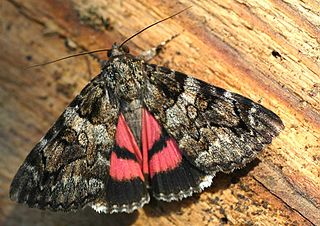 W
WCatocala coniuncta is a circum-Mediterranean species of moth whose range extends across southern Europe, North Africa and extending to the Middle East. Its species name has for a long time been misspelled "conjuncta"; this was only corrected in 2010.
 W
WCatocala conversa is a moth of the family Erebidae first described by Eugenius Johann Christoph Esper in 1787. It is found in the Mediterranean zone and parts of the sub-Mediterranean zone.
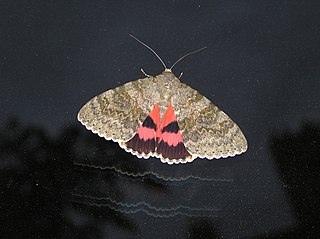 W
WCatocala elocata, the French red underwing, is a moth of the family Erebidae. It is found in Central Europe, Southern Europe, North Africa, Anatolia, Uzbekistan, and Kazakhstan.
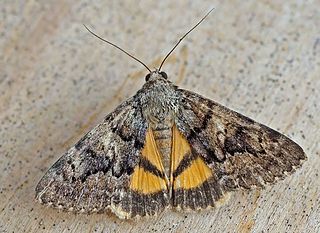 W
WCatocala nymphaea is a species of moth of the family Erebidae. It was described by Eugenius Johann Christoph Esper in 1787. It is found in southern France, Austria, Albania, Portugal, Italy, Greece, Corsica, Sicily, Crete, North Africa, Anatolia, Afghanistan and Kashmir.
 W
WCatocala nymphagoga, the oak yellow underwing, is a moth of the family Erebidae. It is found in Southern Europe, from Bulgaria up to the Iberian Peninsula and sometimes further north as a migrant. It is also found in North Africa and Asia Minor.
 W
WCucullia argentina is a moth of the family Noctuidae. It is found from central Turkey throughout the Caucasus, Iraq, Iran, Turkmenistan, southern Russia, Kazakhstan and Afghanistan to Mongolia.
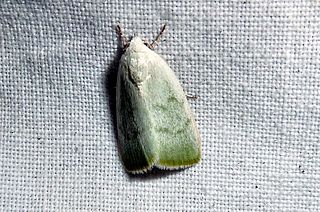 W
WEarias vernana is a species of moth in the family Nolidae first described by Johan Christian Fabricius in 1787. It is found in most of southern and central Europe.
 W
WThe Essex emerald is a moth of the family Geometridae. The species was first described by Johan Christian Fabricius in 1787. It is distributed throughout the Palearctic region with records from many European countries. The British subspecies Thetidia smaragdaria maritima was last seen in 1991 in Kent and is now presumed extinct. In 2004 the moth was first recorded from Sweden.
 W
WEupithecia venosata, the netted pug, is a moth of the family Geometridae. It was first described by Johan Christian Fabricius in 1787. It is found across the Palearctic realm from Portugal and Morocco in the west to the Lake Baikal in Siberia and Afghanistan and Pakistan in the east.
 W
WGagitodes sagittata, the marsh carpet, is a moth of the family Geometridae. The species was first described by Johan Christian Fabricius in 1787. It is found in eastern Asia, including Japan, Korea and China and in central and northern Europe. It is sometimes included in the genus Perizoma
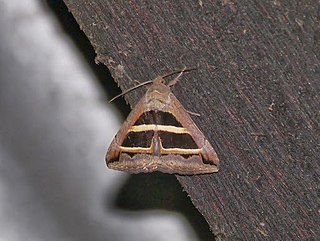 W
WGrammodes bifasciata is a moth of the family Erebidae first described by Vincenzo Petagna in 1787. It is found in Madagascar, eastern Africa, North Africa and other parts of the Mediterranean Basin, including south of France and Israel.
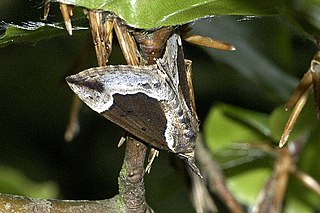 W
WHypena crassalis, the beautiful snout, is a moth of the family Erebidae. The species was first described by Johan Christian Fabricius in 1787. It is found in Europe.
 W
WHypopyra vespertilio is a moth of the family Erebidae first described by Johan Christian Fabricius in 1787. It is found in China, Korea, Honshu in Japan, India, Sri Lanka, Nepal, Thailand, Myanmar, Cambodia, Vietnam, Taiwan, Malaysia, the Philippines, Java, Sumatra and Sulawesi.
 W
WIsturgia famula is a moth of the family Geometridae. It is known from southern Europe.
 W
WJosia megaera is a moth of the family Notodontidae. It is found from Brazil to Venezuela.
 W
WKatha depressa, the buff footman, is a moth of the family Erebidae. It is found from western Europe east through the Palearctic to Korea and Japan.
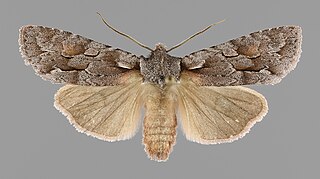 W
WLithophane lamda, the nonconformist, is a moth of the family Noctuidae. It is found throughout Europe, except in southern Europe. It is also absent from Iceland and Ireland.
 W
WMaruca vitrata is a pantropical insect pest of leguminous crops like pigeon pea, cowpea, mung bean and soybean. Its common names include the maruca pod borer, bean pod borer, soybean pod borer, mung moth, and the legume pod borer. The species was first described by Johan Christian Fabricius in 1787.
 W
WMicropterix tunbergella is a moth of the family Micropterigidae. It is found in most of Europe, except Bulgaria, Croatia, Finland, Ireland, Italy, Portugal, and Slovenia.
 W
WMythimna ferrago, the clay, is a moth of the family Noctuidae. The species was first described by Johan Christian Fabricius in 1787. It is distributed throughout Europe and is also found in Morocco, Algeria, Turkey, Asia Minor, Armenia, Syria, Turkestan, Israel, Lebanon, Iraq, Iran, Central Asia and the western parts of temperate North Asia. Also Tibet.
 W
WOeonistis delia is a moth of the family Erebidae. It was described by Johan Christian Fabricius in 1787. It is found from Sulawesi to New Caledonia, Samoa and Tonga.
 W
WOlindia schumacherana, also known as the white-barred tortrix, is a moth of the family Tortricidae found in most of Europe. The moth was first described by the Danish zoologist, Johan Christian Fabricius in 1787.
 W
WOrenaia alpestralis is a species of moth in the family Crambidae.
 W
WOxicesta geographica is a moth of the family Noctuidae. It is found in southern Romania, Austria, Hungary, from the former Yugoslavia to northern Greece and Turkey. It has also been reported from Russian Moldavia and Georgia.
 W
WPammene populana, the pygmy piercer, is a species of moth of the family Tortricidae. It is found in most of Europe, except Portugal, the Balkan Peninsula and Ukraine. The habitat consists of woodland, marshes, riverbanks, fens and sand dunes.
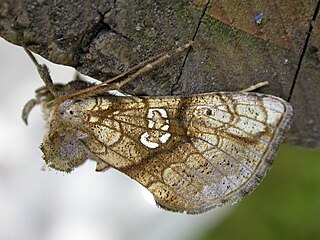 W
WPolychrysia moneta, the golden plusia, is a moth of the family Noctuidae. It is found in the Palearctic realm.
 W
WPolyploca ridens, the frosted green, is a moth of the family Drepanidae. It is found in southern and central Europe, England, Denmark, southern Sweden and in the east up to Russia.
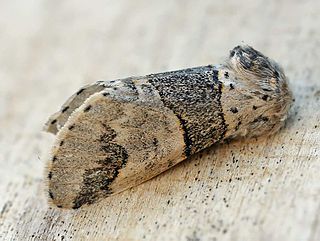 W
WThe poplar kitten is a species of moth in the family Notodontidae. The species was first described by Nikolaus Joseph Brahm in 1787. They are found throughout Europe and in North Africa, Mongolia, Kazakhstan and Xinjiang.
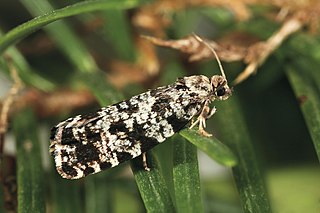 W
WPseudohermenias abietana is a species of moth of the family Tortricidae. It is found from Fennoscandia and northern Russia to the Pyrenees, Sardinia and Italy and from France to Romania.
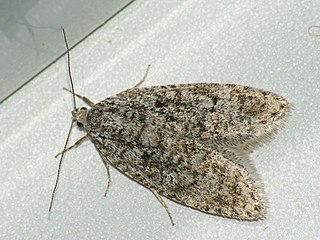 W
WSemioscopis strigulana is a species of moth of the family Depressariidae. It is found in most of Europe east to the eastern parts of the Palearctic realm.
 W
WSetina aurita is a moth of the family Erebidae. It was first described by Eugenius Johann Christoph Esper in 1787.
 W
WSpatalistis bifasciana is a species of moth of the family Tortricidae. It is found in most of Europe.
 W
WSpeiredonia itynx is a species of moth of the family Erebidae first described by Johan Christian Fabricius in 1787. It is found in India, Sri Lanka, Vietnam, Java, Palawan, Sulawesi and the Moluccas.
 W
WThe spinach is a moth of the family Geometridae. The species was first described by Johan Christian Fabricius in 1787. It is found throughout much of the Palearctic region and the Near East though its distribution is rather local due to its specialized larval food plant. In the British Isles it is fairly common in England and Wales but much rarer in Scotland and Ireland.
 W
WThera obeliscata, the grey pine carpet, is a moth of the family Geometridae. It is found throughout north and central Europe and east across the Palearctic to Siberia, and south to the Caucasus and Transcaucasia. In the Alps it can be found at an altitude of over 1500 metres.
 W
WZygaena sedi is a species of moth in the Zygaenidae family. It is found in Greece, Bulgaria, Turkey, Ukraine and Russia. In Seitz it is described - Z. sedi Fab. (6k). In this insect the spots of each pair are merged to large light red patches, these being separated from each other only by thin lines of the transparent ground-colour. Abdomen without belt. Coasts of the Black Sea.